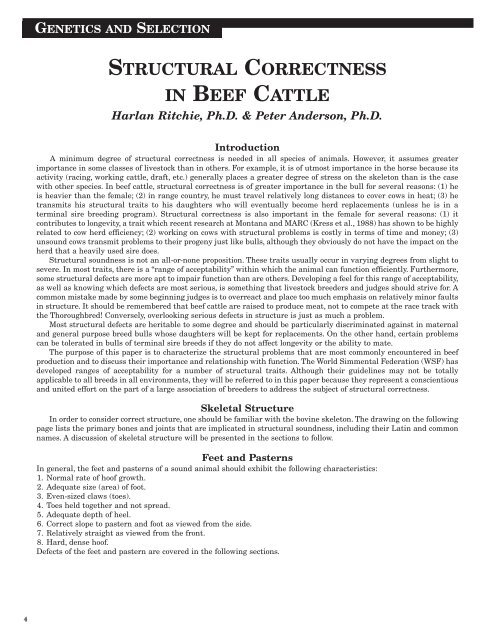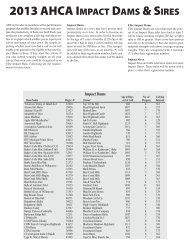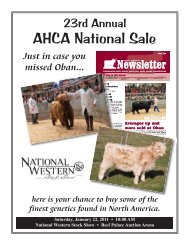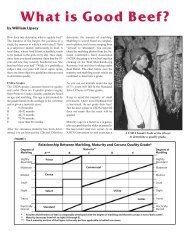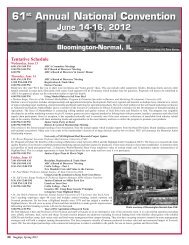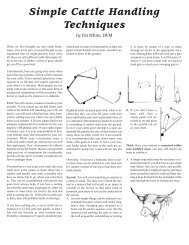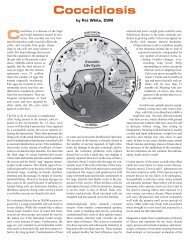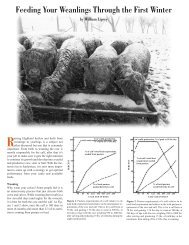The Bagpipe - American Highland Cattle Association
The Bagpipe - American Highland Cattle Association
The Bagpipe - American Highland Cattle Association
Create successful ePaper yourself
Turn your PDF publications into a flip-book with our unique Google optimized e-Paper software.
4<br />
GENETICS AND SELECTION<br />
STRUCTURAL CORRECTNESS<br />
IN BEEF CATTLE<br />
Harlan Ritchie, Ph.D. & Peter Anderson, Ph.D.<br />
Introduction<br />
A minimum degree of structural correctness is needed in all species of animals. However, it assumes greater<br />
importance in some classes of livestock than in others. For example, it is of utmost importance in the horse because its<br />
activity (racing, working cattle, draft, etc.) generally places a greater degree of stress on the skeleton than is the case<br />
with other species. In beef cattle, structural correctness is of greater importance in the bull for several reasons: (1) he<br />
is heavier than the female; (2) in range country, he must travel relatively long distances to cover cows in heat; (3) he<br />
transmits his structural traits to his daughters who will eventually become herd replacements (unless he is in a<br />
terminal sire breeding program). Structural correctness is also important in the female for several reasons: (1) it<br />
contributes to longevity, a trait which recent research at Montana and MARC (Kress et al., 1988) has shown to be highly<br />
related to cow herd efficiency; (2) working on cows with structural problems is costly in terms of time and money; (3)<br />
unsound cows transmit problems to their progeny just like bulls, although they obviously do not have the impact on the<br />
herd that a heavily used sire does.<br />
Structural soundness is not an all-or-none proposition. <strong>The</strong>se traits usually occur in varying degrees from slight to<br />
severe. In most traits, there is a “range of acceptability” within which the animal can function efficiently. Furthermore,<br />
some structural defects are more apt to impair function than are others. Developing a feel for this range of acceptability,<br />
as well as knowing which defects are most serious, is something that livestock breeders and judges should strive for. A<br />
common mistake made by some beginning judges is to overreact and place too much emphasis on relatively minor faults<br />
in structure. It should be remembered that beef cattle are raised to produce meat, not to compete at the race track with<br />
the Thoroughbred! Conversely, overlooking serious defects in structure is just as much a problem.<br />
Most structural defects are heritable to some degree and should be particularly discriminated against in maternal<br />
and general purpose breed bulls whose daughters will be kept for replacements. On the other hand, certain problems<br />
can be tolerated in bulls of terminal sire breeds if they do not affect longevity or the ability to mate.<br />
<strong>The</strong> purpose of this paper is to characterize the structural problems that are most commonly encountered in beef<br />
production and to discuss their importance and relationship with function. <strong>The</strong> World Simmental Federation (WSF) has<br />
developed ranges of acceptability for a number of structural traits. Although their guidelines may not be totally<br />
applicable to all breeds in all environments, they will be referred to in this paper because they represent a conscientious<br />
and united effort on the part of a large association of breeders to address the subject of structural correctness.<br />
Skeletal Structure<br />
In order to consider correct structure, one should be familiar with the bovine skeleton. <strong>The</strong> drawing on the following<br />
page lists the primary bones and joints that are implicated in structural soundness, including their Latin and common<br />
names. A discussion of skeletal structure will be presented in the sections to follow.<br />
Feet and Pasterns<br />
In general, the feet and pasterns of a sound animal should exhibit the following characteristics:<br />
1. Normal rate of hoof growth.<br />
2. Adequate size (area) of foot.<br />
3. Even-sized claws (toes).<br />
4. Toes held together and not spread.<br />
5. Adequate depth of heel.<br />
6. Correct slope to pastern and foot as viewed from the side.<br />
7. Relatively straight as viewed from the front.<br />
8. Hard, dense hoof.<br />
Defects of the feet and pastern are covered in the following sections.


